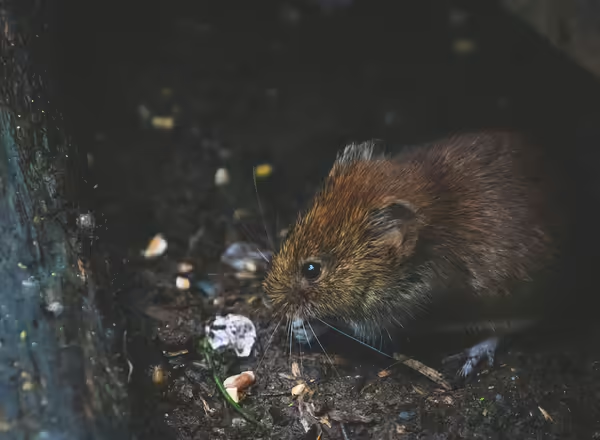
Norway Rat
Norway rats (Rattus norvegicus), also known as brown rats, are considered the greatest mammalian pest of humans, particularly in urban areas. The Norway rat thrives wherever humans provide shelter and abundant food, in both urban and rural areas. They carry many pathogens and are a risk to human health. Their gnawing behaviors and burrowing can damage buildings.
Because of their close association with humans, Norway rats in Illinois probably rarely directly impact native species. Instead, they mainly conflict with people. The Norway rat feeds on human waste in urban areas, while in rural landscapes its diet consists mainly of grain seeds (i.e., corn and wheat). On islands around the globe, Norway rats and black rats (Rattus rattus) pose a critical threat to native birds, particularly ground-nesting shorebirds; as such, on islands, eradication of rats is imperative for conservation efforts.
Norway rats may be an important food source for snakes, hawks, and weasels. However, away from islands, we know little about their effects on ecosystem function. It is well known that Norway rats may significantly impact public health. Norway rats carry many pathogens, including the Seoul virus, a form of hantavirus, and hepatitis E, and bacteria like Leptospira, Bartonella, and Rickettsia. Furthermore, rats carry endo- and ectoparasites like fleas, lice, protozoans, and trematode worms. In the 1300s, rats were vital to spreading the bacterium Yersinia pestis, which lives inside the fleas carried by rats; Yersinia caused the bubonic plague, the most fatal pandemic known to humanity.
Like all rodents, Norway rats have a propensity for gnawing. This behavior can lead to significant damage to human structures, as Norway rats will chew on insulation, wires, and other building materials. Consumption and contamination of livestock feed is a problem in rural areas, including livestock operations, and rats also may undermine the integrity of structures under which they create extensive networks of burrows.
In urban areas, such as Chicago, residents experience a suite of negative emotions about rats, including fear and disgust. People may avoid going outside to avoid rat encounters and must spend money to control rat populations in their homes.
Norway rats originated in Asia but are now a cosmopolitan species. They occur in all parts of Illinois and the U.S. These rats were introduced to the U.S. in the 1700s, probably via ships traveling from Eurasia.
Norway rats will establish wherever there is shelter and access to food. While they may be inconspicuous because of their secretive habits, their droppings, nests, and urine are evident.
Norway rats have no protection in Illinois. In urban areas, city government may play a role in controlling rat populations by regulating garbage storage and targeting rat infestations with rodenticide poison. For example, Chicago maintains a Bureau of Rodent Control that responds to resident requests for baiting.

The Norway rat is a relatively large animal compared to native rodents in Illinois. The gray belly fur and scaly and mostly unfurred tail help to distinguish Norway rats from native rodents. Norway rats have grayish fur on the belly and yellow-brown fur on the back, grizzled with black. These rats have a scaly tail that is nearly naked and almost as long as the head and body together. Body mass is typically 0.5–1 lb.
The Norway rat can thrive in alleys and subways in the city and around fields and grain stores in rural areas.
In most of Illinois, the Norway rat is the largest rodent encountered mainly on land. The larger muskrat (Ondatra zibethicus) is associated with marshes and other water areas and is very brown in color. In terms of size and appearance, the eastern woodrat (Neotoma floridana) is most similar to the Norway rat, but woodrats have white fur on their belly, larger ears, and a furred tail, and only occur in far southern Illinois along limestone bluffs in the river valleys.
In urban areas, good sanitation practices, rat-proof construction and food storage, trapping, and poison baits are considered effective measures against rats.
Taking measures to prevent rat infestation, such as limiting access to food and shelter, is the best way to limit conflicts with Norway rats. When rats infest a site, trapping is a very effective method of control that offers a few advantages – no poison is involved, and the carcass can be seen and properly discarded.
Rodenticides are a common control method for native and non-native rodent populations wherever they come into conflict with humans. However, rodenticide baits are responsible for the deaths of raptors that eat rodents and other non-target animals that may consume poisoned animals or bait. Therefore, poison baits should be a last resort for rat control. While keeping dogs and cats around a building may deter rats, they are unlikely to reduce rat populations in a significant way.
The Lincoln Park Zoo initiated the Chicago Rat Project, which seeks to understand people’s conflicts with rats in Chicago. Their project will look at the spatial distribution of rat infestations and the potential for rats to impact human health.
- Mammals of the eastern United States
- BMC Public Health, Chicago resident experiences with urban rats during a COVID-19 stay-at-home order
- Proceedings of the Vertebrate Pest Conferences, An IPM approach to rodent control on Midwestern farms
- National Library of Medicine, A survey of zoonotic pathogens carried by Norway rats in Baltimore, Maryland
- Illinois Department of Public Health, Norway Rats
- Lincoln Park Zoo, Chicago Rat Project